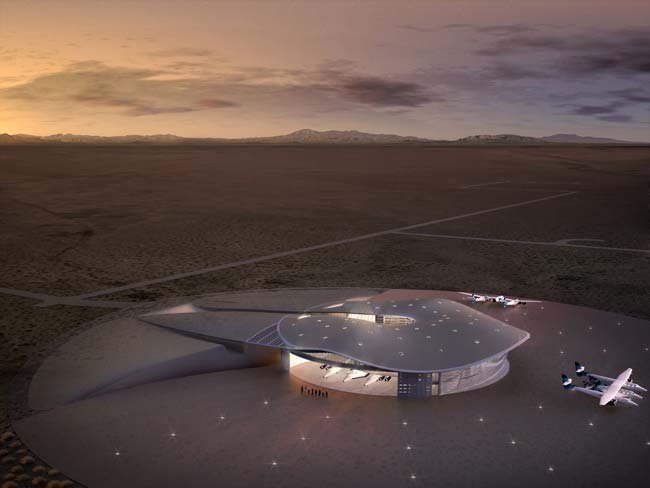Deal Sets Space Tourist Flights from New Mexico

Updated 2:58 p.m. ET
The company planning to take tourists into space, Virgin Galactic, and the State of New Mexico announced today that they have signed a 20-year lease agreement – a deal worth an estimated $150 million to $250 million which firmly plants the spaceline operator's world headquarters in New Mexico to make use of Spaceport America.
The inland Spaceport America is billed as the nation's first purposely built commercial spaceport.
Sir Richard Branson's Virgin Galactic firm will make use of the WhiteKnightTwo/SpaceShipTwo launch system – now under development at Scaled Composites in Mojave, California – to loft paying customers at $200,000 a seat on suborbital treks departing from Spaceport America.
The WhiteKnightTwo mothership, the craft that will haul SpaceShipTwo to release altitude, made its maiden flight on Dec. 21 at the Mojave Air and Space Port in California. Both the carrier plane and the two pilot, six passenger SpaceShipTwo are to undergo significant testing prior to commercial operation.
New Mexico Governor Bill Richardson – recently nominated by President-elect Barack Obama as Secretary of Commerce – has been a champion of the spaceport, and a strong advocate for private space commerce.
"The signing of this agreement is a momentous day for our state and has cemented New Mexico as the home of commercial space travel," Richardson said in a statement. "I want to thank Virgin Galactic for partnering with us to create a whole new industry that is going to transform the economy of Southern New Mexico – creating thousands of jobs, generating money for education, boosting tourism and attracting other companies and economic opportunities to the area."
Breaking space news, the latest updates on rocket launches, skywatching events and more!
String of events
Today's lease agreement is another in a string of events that pushes Spaceport America from artist concept to ribbon cutting and vertical and horizontal launch operations.
The Federal Aviation Administration's commercial space office recently issued a launch license to the New Mexico Spaceport Authority (NMSA). The lease agreement with Virgin Galactic as an anchor tenant was the final requirement set by the New Mexico Legislature to release the next level of funding for Spaceport America.
Earlier this month, NMSA selected Gerald Martin Construction Management of Albuquerque to oversee construction of Spaceport America. The architectural firm of URS/Foster + Partners is completing their final design for the terminal and hangar facility.
Construction is slated to begin in the first quarter of 2009 with the terminal and hangar facility scheduled for completion in 2010. Road construction to Spaceport America is already underway.
Spaceport business
The site of New Mexico's Spaceport America is 30 miles (48 km) east of Truth or Consequences and 45 miles (72.4 km) north of Las Cruces.
"This is a historic moment for New Mexico, Spaceport America and Virgin Galactic. A lot of very dedicated people have been working long hours to secure this lease agreement," said Steven Landeene, Spaceport America's Executive Director. "Like several other companies, Virgin Galactic has realized the outstanding advantages offered by Spaceport America and the State of New Mexico."
In addition to Virgin Galactic, the Spaceport Authority has been working closely with other aerospace firms such as Lockheed Martin, Rocket Racing Inc./Armadillo Aerospace, UP Aerospace, Microgravity Enterprises and Payload Specialties.
"We are really looking forward to making Spaceport America and New Mexico the home and worldwide headquarters of Virgin Galactic," said Jonathan Firth, Virgin Galactic Projects & Operations Director.
Firth said that New Mexico has all the right elements for a successful commercial space operation including good weather and clear airspace attributes.
Revenue stream
"Obviously, it's a great day for commercial space," Landeene told SPACE.com. "Virgin and New Mexico have now committed to the beginnings of the first commercial spaceline with that lease," he said.
The 20 year lease is built upon three components, Landeene explained – ground rent, facilities rent and then user fees – an approach that draws upon classic airport infrastructure.
The facilities rent – Virgin Galactic's use of a terminal and hangar – equates to about $50 million over the lifetime of the lease, Landeene said.
The user fees have been scoped out in a partnership approach. There are different fee schedules based on the activity level that Virgin Galactic has at the spaceport, including passenger fees, as well as fees where launches from Spaceport America might not involve passengers but scientific payloads, for example.
"There's an incentive for Virgin Galactic to conduct more missions out at the spaceport," Landeene stated.
Due to the various types of flights, "we're looking at probably $100 million to $200 million dollars in revenue for the state over the 20 year lease ... so $150 million to $250 million dollars of revenue for the state. Of course, Virgin Galactic has a revenue line of their own," Landeene said.
- SpaceShipTwo's Successful First Flight
- Video - Space Tourism: Virgin Galactic Way - Part 1, Part 2
- Images - SpaceShipTwo Mothership Unveiled
Leonard David has been reporting on the space industry for more than four decades. He is past editor-in-chief of the National Space Society's Ad Astra and Space World magazines and has written for SPACE.com since 1999.

Leonard David is an award-winning space journalist who has been reporting on space activities for more than 50 years. Currently writing as Space.com's Space Insider Columnist among his other projects, Leonard has authored numerous books on space exploration, Mars missions and more, with his latest being "Moon Rush: The New Space Race" published in 2019 by National Geographic. He also wrote "Mars: Our Future on the Red Planet" released in 2016 by National Geographic. Leonard has served as a correspondent for SpaceNews, Scientific American and Aerospace America for the AIAA. He has received many awards, including the first Ordway Award for Sustained Excellence in Spaceflight History in 2015 at the AAS Wernher von Braun Memorial Symposium. You can find out Leonard's latest project at his website and on Twitter.
